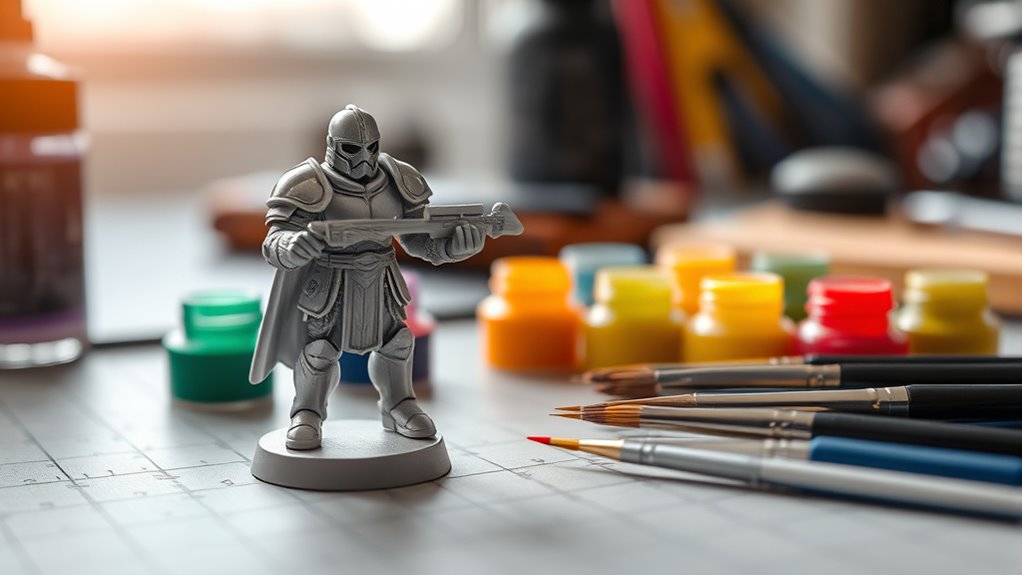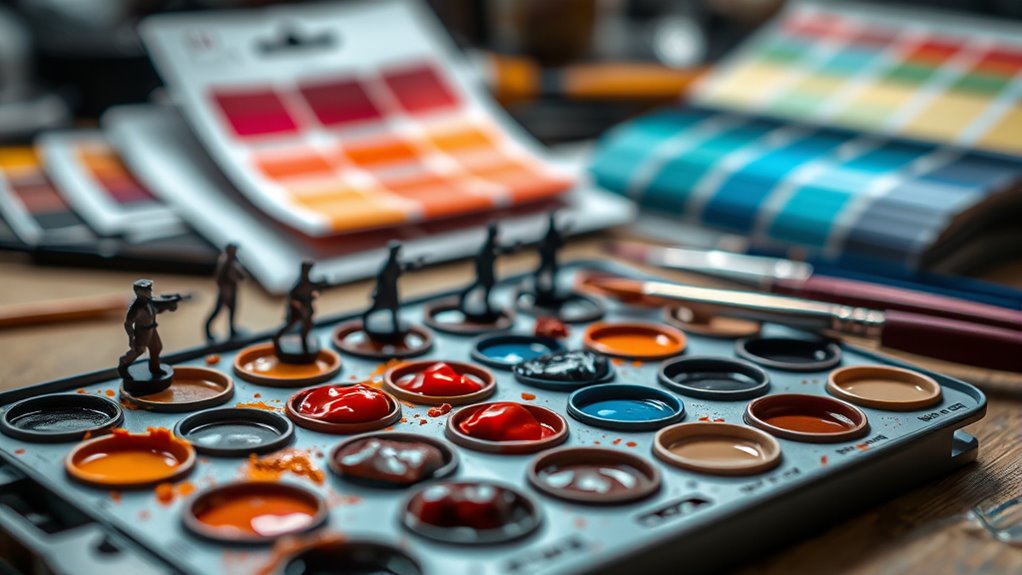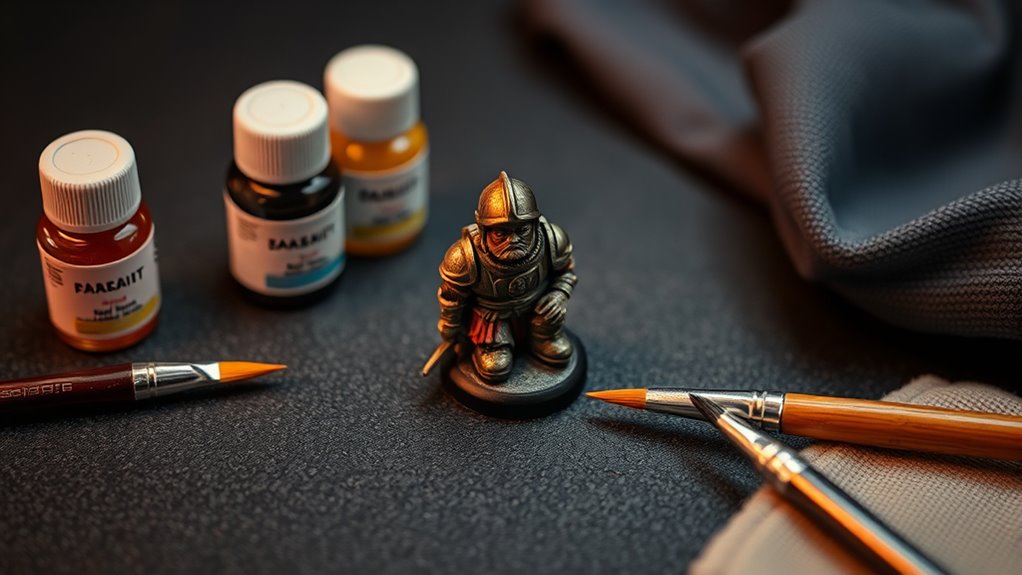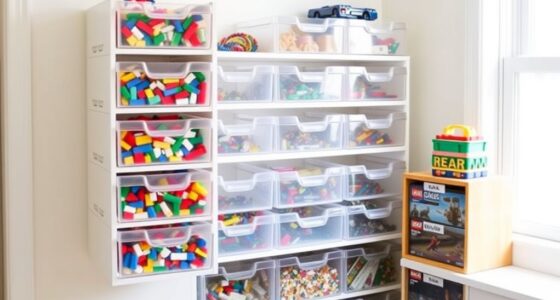To get started with miniature painting, choose miniatures that match your interests, like fantasy or sci-fi, and pick beginner-friendly supplies such as acrylic paints and fine brushes. Clean your miniatures thoroughly before applying a primer for an even surface. Use color theory to pick pleasing schemes and practice thin, controlled brush strokes. Finish by sealing your work with protective spray. If you keep exploring, you’ll discover more tips to refine your skills and create stunning miniatures.
Key Takeaways
- Choose beginner-friendly miniatures, such as pre-assembled figures, and gather basic supplies like acrylic paints and brushes.
- Clean miniatures thoroughly and apply a thin primer coat to ensure smooth paint adhesion.
- Practice essential techniques like thin layering, color blending, and brush control for detailed results.
- Use color theory to develop cohesive schemes and incorporate contrast for visual interest.
- Finish with a protective sealant and display in a case to preserve your painted miniatures.
Choosing Your First Miniatures and Supplies

When starting with miniature painting, selecting the right miniatures and supplies is essential. Begin by choosing miniatures that match your interests, whether fantasy, sci-fi, or historical themes. For beginners, pre-assembled miniatures save time and reduce frustration, making miniature assembly easier. Visit your local hobby store for tips on choosing quality figures and supplies; staff can recommend beginner-friendly options. Stick to basic supplies like acrylic paints, fine brushes, and a palette. Avoid investing heavily upfront; start with a small set of versatile colors. Look for starter kits or paint sets designed for beginners. This approach helps you build a solid foundation without feeling overwhelmed, setting you up for a rewarding miniature painting journey. Additionally, exploring miniature painting culture can provide inspiration and valuable techniques to improve your skills.
Preparing Your Miniatures for Painting

Preparing your miniatures properly is essential to achieving a smooth, professional-looking paint job. Start by thoroughly miniature cleaning to remove mold release agents, dust, and oils that can hinder paint adhesion. Once clean, apply a primer to create a uniform surface that helps paint adhere better and highlights details. Using the right primer is crucial; spray primers offer even coverage, while brush-on primers work well for detailed areas. Here’s a quick guide:
| Step | Method | Tips |
|---|---|---|
| Cleaning | Wash with warm water & soap | Use soft brushes or cloth |
| Drying | Air dry thoroughly | Avoid touching with fingers |
| Primer Application | Spray or brush on thin coats | Ensure even coverage |
Follow these steps, and you’ll set a solid foundation for your painting success!
Essential Painting Techniques and Tips

Mastering essential painting techniques can dramatically enhance the quality of your miniatures. A solid understanding of color theory helps you choose harmonious shades and create realistic shading and highlights. Practice your brush handling to improve control, allowing for precise details and smooth progressions. Use thin layers of paint to avoid obscuring details, building up color gradually. Keep your brushes clean to maintain their shape and prevent unwanted mixing. Experiment with different brush sizes for various effects—smaller brushes for fine details, larger ones for base coats. Remember, patience is key; taking your time yields cleaner, more professional results. Focus on consistent technique and don’t rush your work. Developing a consistent painting rhythm can help you maintain steady progress and refine your skills. With practice, these techniques will become second nature, elevating your miniature painting skills.
Selecting Colors and Creating Color Schemes

Choosing the right colors sets the foundation for a striking miniature. By understanding color theory, you can craft appealing color schemes that enhance your model’s visual impact. Color harmony assures your chosen palette feels balanced and cohesive, making your miniature more visually engaging. Incorporating color contrast techniques can further elevate your painting by creating focal points and visual interest. Use complementary colors for contrast, or analogous hues for harmony. Think about the mood you want to convey—warm tones evoke energy, while cool shades suggest calm. Here’s a simple guide:
| Warm Colors | Cool Colors |
|---|---|
| Red, Orange | Blue, Green |
| Bright, vibrant | Subtle, muted |
| Energizing | Calm |
Finishing Touches and Protecting Your Artwork

Once you’ve completed your miniature, adding finishing touches and applying protective measures can make all the difference in maintaining its quality. Sealant application is essential; it protects your paint job from chips, dust, and handling damage. Choose a clear, matte, or gloss sealant based on your desired finish. Be sure to spray or brush on the sealant evenly and in thin layers to avoid drips or runs. Additionally, consider display case options that complement your miniature, shielding it from dust and accidental bumps. Acrylic display cases are popular for their clarity and affordability. Properly sealing and showcasing your miniature not only preserves its appearance but also enhances its presentation, ensuring your hard work remains in pristine condition for years to come. Understanding contrast ratio can help you select the best lighting and display conditions to showcase your miniature effectively.
Frequently Asked Questions
How Do I Fix Mistakes or Errors During Painting?
If you make mistakes during miniature painting, start by cleaning your brushes thoroughly to prevent further errors. To correct color mistakes, carefully layer or blend over the error with the correct color, using thin coats. If needed, you can also gently remove paint with water or a solvent, then reapply the correct color. Always work patiently, and don’t be afraid to fix errors — it’s part of the process.
What Are Some Beginner-Friendly Miniature Brands?
If you’re looking for beginner-friendly miniature brands, start with options like Reaper, Army Painter, and Vallejo. These brands are known for their ease of use, affordability, and wide range of colors and kits. They offer quality products designed for newcomers, making your painting journey smoother. With these brands, you’ll find the right tools, the right colors, and the right encouragement to develop your skills confidently.
How Long Does It Typically Take to Complete a Miniature?
It usually takes anywhere from a few hours to several days to complete a miniature, depending on your painting techniques and the complexity of miniature assembly. If you’re new, expect longer sessions as you learn brush control and layering. As you gain experience, you’ll work faster. Break the process into stages — assembly, priming, base coating, details, and finishing — to make the task manageable and enjoyable.
What Tools Are Essential for Miniature Painting?
A painter’s toolbox is their foundation—think of it as “a well-oiled machine.” You’ll need fine detail brushes for precision, a palette for mixing colors based on color theory, and good-quality paint. Don’t forget brush maintenance to keep your tools in top shape. A steady hand and patience help, but these essentials will guide you to create stunning miniatures. With the right tools, your skills will truly shine.
How Can I Improve My Miniature Painting Skills Over Time?
To improve your miniature painting skills over time, focus on mastering techniques to master and color blending strategies. Practice regularly, experiment with different brush strokes, and study tutorials to refine your skills. Don’t be afraid to push your boundaries by trying new styles or color schemes. Keep reviewing your work critically, seek feedback from other painters, and stay patient—your skills will naturally improve with persistent effort and passion.
Conclusion
Getting started with miniature painting is an exciting journey that boosts creativity and patience. Did you know that over 60% of hobbyists report increased relaxation and stress relief from painting miniatures? With the right supplies, techniques, and a splash of your unique style, you’ll create stunning figures that bring your imagination to life. Keep practicing, stay patient, and enjoy every brushstroke—you’ll be amazed at how quickly your skills grow!









